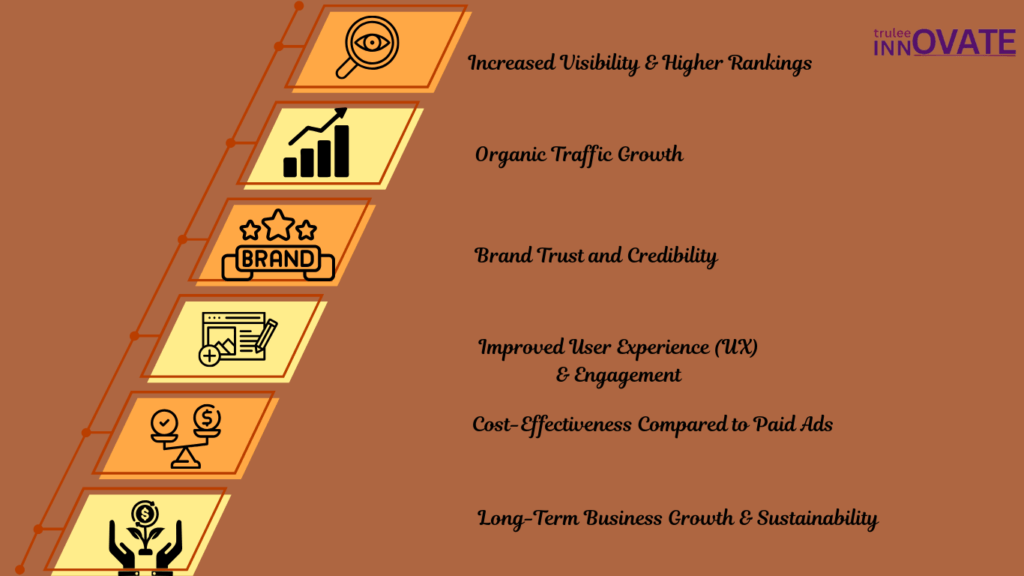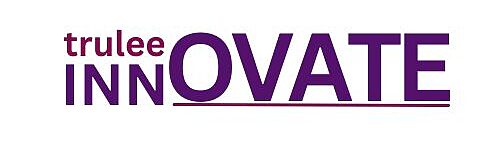What is SEO and Why SEO is important in digital marketing?
Search Engine Optimization (SEO) is the backbone of digital marketing, playing a crucial role in driving organic traffic to websites. It involves optimizing web pages to rank higher on search engines like Google, Bing, and Yahoo. SEO in digital marketing ensures that businesses reach their target audience effectively, boosting visibility and engagement.
SEO is a blend of technical and creative strategies aimed at improving a website’s ranking in search engine results pages (SERPs). It enhances user experience, making content easily accessible and relevant to users. Without SEO, even the most well-designed websites may struggle to attract visitors.
The Core Benefits of SEO in Digital Marketing
1. Increased Visibility & Higher Rankings
When users search for a product or service, they’re far more likely to click on one of the top results. SEO helps businesses rank higher on search engines like Google, making their website more visible to potential customers.
Key Benefits of SEO:
- Increased Visibility – Ranking higher means more exposure to users searching for relevant keywords.
- More Organic Traffic – Top positions earn the majority of clicks, driving free, high-quality traffic.
- Credibility & Trust – Users tend to trust high-ranking sites, improving brand authority.
- Cost-Effective Marketing – Unlike paid ads, SEO brings long-term traffic without ongoing costs per click.
- Better User Experience – SEO optimizes site speed, mobile-friendliness, and content, keeping visitors engaged.
By improving search rankings, businesses attract more visitors, generate leads, and grow revenue sustainably.
2. Organic Traffic Growth
SEO (Search Engine Optimization) drives high-quality, organic traffic to a website without relying on paid ads. Unlike Pay-Per-Click (PPC) advertising—where visibility stops when the budget runs out—SEO builds lasting visibility through:
- Relevant, Optimized Content – Aligning with user search intent.
- Strategic Keywords – Targeting terms your audience actually searches for.
- Authoritative Backlinks – Earning trust from other reputable sites.
Why SEO Outperforms Paid Ads in the Long Run
✔ Cost-Efficient – No recurring fees per click; traffic grows organically.
✔ Sustainable Results – Rankings compound over time, unlike ad-dependent traffic.
✔ Higher Credibility – Users trust organic results more than paid ads.
✔ Targeted Audience – Attracts visitors actively searching for your solutions.
While PPC offers immediate visibility, SEO delivers consistent, scalable growth—making it the backbone of a resilient digital strategy.
3. Brand Trust and Credibility
SEO (Search Engine Optimization) drives high-quality, organic traffic to a website without relying on paid ads. Unlike Pay-Per-Click (PPC) advertising—where visibility stops when the budget runs out—SEO builds lasting visibility through:
- Relevant, Optimized Content – Aligning with user search intent.
- Strategic Keywords – Targeting terms your audience actually searches for.
- Authoritative Backlinks – Earning trust from other reputable sites.
Why SEO Outperforms Paid Ads in the Long Run
✔ Cost-Efficient – No recurring fees per click; traffic grows organically.
✔ Sustainable Results – Rankings compound over time, unlike ad-dependent traffic.
✔ Higher Credibility – Users trust organic results more than paid ads.
✔ Targeted Audience – Attracts visitors actively searching for your solutions.
4. Improved User Experience (UX) and Engagement
While SEO is often associated with higher search rankings, its greatest impact lies in creating better experiences for real users. Search engines reward websites that prioritize usability, because when visitors engage with your content, everyone wins.
How SEO Enhances User Experience:
Speed Optimization
- Faster load times reduce bounce rates and improve conversions
- Compressed images, caching, and clean code create seamless performance
Mobile-First Experience
- Responsive design ensures flawless display across all devices
- Google prioritizes mobile-friendly sites in rankings
Intuitive Navigation & Structure
- Clear information architecture helps users find what they need
- Strategic internal linking keeps visitors engaged longer
Action-Oriented Design
- Prominent, compelling CTAs guide users toward conversion
- Readable formatting with proper headings and whitespace
SEO isn’t just about pleasing algorithms – it’s about creating websites that real people love to use. By focusing on UX fundamentals, you’ll not only rank higher but also convert more visitors into customers.
5. Cost-Effectiveness Compared to Paid Ads
Unlike paid advertising that turns off when budgets run dry, SEO is a self-sustaining growth engine. While PPC delivers instant (but temporary) visibility, SEO builds lasting equity that appreciates over time.
Why SEO Outperforms Paid Ads Long-Term:
- Perpetual Traffic Machine
- High-ranking pages continue generating organic visitors 24/7
- No “shutoff valve” – traffic flows without daily spend
Hyper-Local Dominance
- Optimized Google Business Profiles capture “near me” searches
- Local citations and reviews build community trust
Compounding Returns
- Each quality backlink strengthens your domain authority
- Evergreen content keeps delivering value years after publication
Cost Efficiency
- Eliminates 5−50 CPCs for competitive keywords
- 1000%+ ROI compared to paid channels (BrightEdge research)
Strategic Insight:
The most successful businesses use PPC for immediate needs while building SEO assets for permanent visibility. It’s not either/or – it’s about balancing short-term wins with long-term dominance.
6. Long-Term Business Growth & Sustainability
SEO isn’t a checkbox—it’s a continuous competitive advantage. Unlike static marketing tactics, a living SEO strategy evolves with your audience and the digital landscape to deliver compounding business results.
The Growth Flywheel of Strategic SEO:
Sustainable Visibility
- Maintains your “digital shelf space” 24/7/365
- Outlasts seasonal ad campaigns and budget fluctuations
Perpetual Lead Generation
- Evergreen content works while you sleep
- 93% of online experiences begin with search (HubSpot)
Compounding Business Value
- Each optimization strengthens your digital assets
- High rankings become competitive moats
Forces Continuous Innovation
- Algorithm updates push you to improve user experience
- Regular content refreshes keep you industry-relevant
Why This Matters:
Businesses treating SEO as an ongoing process see:
• 3-5X more organic traffic than competitors
• 60% lower customer acquisition costs
• Consistent revenue streams regardless of ad budget change.

Key SEO Strategies for Business Success
- On-Page SEO: Content Optimization & Keywords
On-page SEO focuses on improving individual web pages to improve rankings in the Google search.
- Keyword research: Finding the right keywords with high search volume and low competition.
- Title tags and meta descriptions: Writing compelling meta data that improves click-through rates (CTR).
- Header tags (H1, H2, H3): Organizing the information in such a way that readers understand them easily.
- Image optimization: Using alt text and compressing images for faster loading.
2. Off-Page SEO: Backlinks & Authority Building
Off-page SEO is nothing but activities done outside of the website to improve its visibility as well as authority
- Backlink building: Earning high-quality inbound links from reputable sources.
- Social media signals: Increasing engagement on platforms like Facebook, LinkedIn, and Twitter.
- Guest blogging: Writing articles for industry-relevant websites.
- Influencer collaborations: Partnering with authoritative figures to boost credibility.
3. Technical SEO: Site Speed & Mobile-Friendliness
Technical SEO helps a website to meet search engine Bots.
- Optimizing site speed: Faster websites have lower bounce rates.
- Mobile optimization: Ensuring websites are responsive.
- Structured data markup: To improve the search visibility use schema markup
- XML sitemaps: Helping search engines index content efficiently.
4. Local SEO: Dominating Local Searches
For companies that are targeting particular areas, we use local SEO
- Google My Business (GMB) optimization: Ensuring accurate business listings.
- NAP consistency (Name, Address, Phone) Use all these same all over the platforms.
- Local keywords: Targeting location-based search queries.
- Online reviews and ratings: Encouraging positive customer feedback.
SEO vs. Other Digital Marketing Strategies
SEO vs. PPC: Which Offers Better ROI?
SEO provides long-term benefits, while PPC advertising delivers instant traffic. Combining both can maximize results.
- PPC is ideal for short-term campaigns.
- SEO is cost-effective over time.
- PPC delivers instant visibility, while SEO ensures sustainable growth.
SEO vs. Social Media Marketing
Social media marketing boosts brand awareness, but SEO ensures search visibility.
- SEO drives targeted organic traffic, while social media generates engagement.
- Social media posts disappear quickly, whereas SEO content remains relevant for years.
SEO vs. Traditional Marketing
Traditional marketing (TV ads, print media) has limited reach compared to SEO.
- SEO allows real-time performance tracking.
- Traditional methods lack precise targeting.
- ROI is increased by SEO .
Future Trends: Where is SEO Headed?
1. AI & Machine Learning in SEO
- Google’s RankBrain enhances search results using AI.
- AI-powered tools improve content optimization.
2. Voice Search & Mobile-First Indexing
- Voice search optimization is becoming crucial.
- Google prioritizes mobile-first websites.
3. The Rise of Zero-Click Searches
- Featured snippets reduce the need for users to click.
- Businesses must optimize for position zero.
Final Thoughts: Why SEO is a Must-Have for Businesses
SEO is a game-changer in digital marketing, ensuring higher rankings, better engagement, and sustained growth. By implementing on-page, off-page, and technical SEO strategies, businesses can outperform competitors and establish a strong online presence. Investing in SEO today will lead to greater digital success in the long run.


